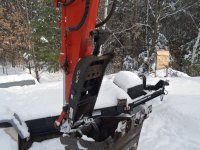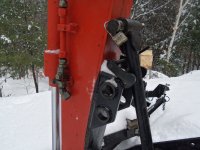You see in my third picture above the plate runs the whole width of the dipper and it is 1/2" thick 7" wide. I took a round medium ******* file to the edge and it took the steel right off. I assume this is not hard plate and is regular steel like you stated. This would mean standard weld practices would apply?
Might you get any information from the thumb manufacturer, or the dipper manufacturer? I misread the size of your machine. This would be considered an 8 ton machine as excavator model numbers all include metric tonnage.
The safe thing would be to treat the dipper as high strength steel. This means using filler metal that is very ductile. Preheat provides three benefits.
Distortion: welds shrink a lot when they cool. If the workpiece is expanded somewhat before weld is applied, it too will shrink as it cools, greatly reducing stress which is where cracks begin. If everything is hot at the onset, there will be less change in the shape.
Hydrogen: As welds cool hydrogen atoms migrate to the perimeter of the molten steel. If this is well defined, it forms a surface, (think of non stick coating on a frying pan), preventing effective fusion. Hot workpiece means most of the hydrogen has been driven off, and cooling will be more gradual, meaning the deposit of hydrogen molecules will be dispersed, not forming a barrier.
Slow cooling: Crystal structure is very different depending largely on carbon content, and cooling rate. Fast cooling makes the structure of crystals more Martensitic, (brittle, and hard) Slower cooling makes steel more Austenitic, (ductile, and tough).
Experts will disagree as to optimum temperature for preheat. I'd say 300 F at least 700F might be pushing it. Dippers break after being welded, and all the extra precaution in the world is not too much if you can avoid a break.
I have a friend who lives in a city in another state. When he comes to his getaway place in VT he loves to rent equipment, and play. He called one rainy evening; he broke the shiny thing on the front. I went to look. The bucket cylinder rod did indeed have a 45 degree curve in it, and was broken clean. In the dark, in the rain with a weak flashlight, I could barely see a triangle of black where the orange dipper should be. He had cracked it open, only the front of the dipper bent instead of breaking.
I've seen that machine several times since. The rental company keeps doing crude weld repairs, and sending it out on yet another rental. It has been broken, and "patched several times. A competent weldor could fix it once.
In your case I suggest a skilled weldor use 7018 Fresh from a sealed container, or oven. A less skilled weldor such as myself might resort to Dual Shield MIG to come close to maximum strength. In either case, avoid fillers with tensile strength over 70,000. It'll only pull weld away from workpiece as it cools. Also, weld strength improves after a minor stretch. I think of tensile strength as Rope vs cable. Rope will "give" a bit , but hold. Cable frays if strained, and weakens. High tensile fillers tear away from work metal, ductile fillers give a bit, and gain strength.


